Table of Contents
Introduction
Welcome to the world of rasboras, where vibrant colors and peaceful demeanors come together in perfect harmony. If you are a beginner or an experienced aquarist, you will appreciate the beauty and simplicity that rasboras bring to any aquarium. These small fish, ranging in size from 1.5 to 2 inches, are a favorite among hobbyists for their ease of care and stunning appearance. With a variety of species to choose from, it can be tough to pick the right ones for your tank. That’s why we have created this comprehensive guide to the 15 must-have rasboras for a vibrant and tranquil aquarium experience. In this guide, we will cover everything you need to know about these fish, including their size, care requirements, and unique features. Whether you’re looking for a pop of color or a more natural look, there is a rasbora for every type of aquarium. So, let’s dive in and discover the best rasboras for your tank!
Harlequin Rasbora (Rasbora heteromorpha)
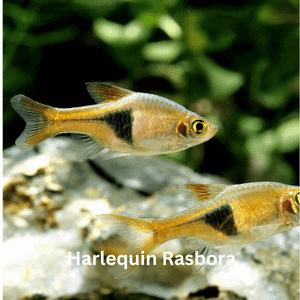
The Harlequin Rasbora is a popular and hardy species that is well-suited for a peaceful community tank. This fish is native to Southeast Asia and is characterized by its distinctive, triangular-shaped body and vibrant orange coloration.
Appearance:
The Harlequin Rasbora has a sleek and streamlined body, with a triangular shape and a slightly pointed snout. The fish’s bright orange coloration is set against a dark black triangle that starts at the gills and extends to the tail. Males are typically more vibrant in color than females and have more elongated fins.
Size and Lifespan:
The Harlequin Rasbora grows to a maximum length of around 2.5 cm (1 inch) and has a lifespan of around 5-6 years.
Habitat and Tank Requirements:
The Harlequin Rasbora is native to Southeast Asia, where it is typically found in slow-moving rivers, streams, and flooded forests. To recreate this environment in your tank, you should provide plenty of plants, hiding places, and a soft substrate such as sand or fine gravel. The ideal water temperature for this species is between 72-82°F (22-28°C), with a pH range of 6.0-7.5.
Schooling Behavior:
The Harlequin Rasbora is a social species that should be kept in a school of at least 6 individuals. In a school, these fish are highly active and interactive, swimming around in tight formation and showcasing their vibrant colors.
Diet:
The Harlequin Rasbora is an omnivorous species that will feed on a variety of food types, including small insects, worms, crustaceans, and plant material. To keep your fish healthy and vibrant, you should feed them a balanced diet of high-quality flakes, freeze-dried foods, and live or frozen foods such as brine shrimp and daphnia.
Breeding:
The Harlequin Rasbora is a relatively easy species to breed in the home aquarium. These fish will lay their eggs in a hiding place, such as a cave or a dense clump of plants, and the male will then fertilize the eggs. After hatching, the fry will be free-swimming and can be fed on newly-hatched brine shrimp or other small foods.
Chilli Rasbora

The Chilli Rasbora is a peaceful and active species that adds vibrant color to your aquarium. The fish features a vibrant red-orange body and iridescent scales that reflect light beautifully. The Chilli Rasbora is a small fish, growing up to 1.5 inches in length, and it’s a hardy species that is easy to care for.
Habitat and Tank Requirements
The Chilli Rasbora is native to Southeast Asia, and in the wild, it inhabits slow-moving rivers and streams. To replicate its natural habitat in your aquarium, it’s essential to provide it with plenty of hiding places, such as plants, rocks, and driftwood. The ideal water temperature for this species is between 72-82°F, and the pH level should be between 6.0-7.5.
A minimum tank size of 10 gallons is recommended for a small school of Chilli Rasboras, but a 20-gallon tank is more ideal to provide enough space for them to swim and thrive. The aquarium should also have a good filtration system, as well as adequate aeration to keep the water quality stable.
Diet and Feeding Habits
The Chilli Rasbora is an omnivorous species, and it will feed on both plant matter and small insects. In the aquarium, they can be fed a varied diet of high-quality flakes, frozen or live food, such as brine shrimp, bloodworms, and daphnia. They should be fed two or three times a day, providing only as much food as they can consume within a few minutes.
Breeding and Reproduction
Breeding the Chilli Rasbora is relatively straightforward, and they are egg layers. To encourage breeding, it’s essential to provide a spacious aquarium with plenty of plants and hiding places. The water temperature should also be increased to around 82°F, and the pH level should be slightly acidic, around 6.0.
Male Chilli Rasboras will court the female by swimming close to her and displaying their bright colors. Once the female has laid her eggs, the male will fertilize them, and the eggs will hatch in around 24-48 hours. The fry will then swim freely, and it’s best to separate them from the parents and other fish in a separate rearing tank.
Blackline Rasbora
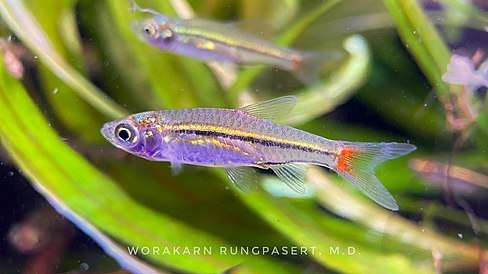
The Blackline Rasbora (Rasbora borapetensis) is a unique and attractive addition to any community aquarium. These small and peaceful fish are known for their distinctive black line that runs along the length of their body. With its vibrant colors and active swimming style, the Blackline Rasbora is sure to bring life to your tank.
Appearance
Blackline Rasboras have a slender and elongated body shape, with a bright red or orange hue on their sides and dorsal fin. The black line that gives them their name runs from their snout to the end of their tail fin, creating a striking contrast with the bright colors of their body. These fish can grow up to 2.5 cm in length and are relatively small, making them a great choice for a community tank.
Habitat and Tank Conditions
Blackline Rasboras are native to Southeast Asia, where they are found in slow-moving rivers and streams. To create a similar environment in your tank, you should aim to keep the water temperature between 72-78°F and the pH level between 6.0-7.0. These fish prefer a well-planted tank with plenty of hiding places and open areas for swimming. Additionally, be sure to provide a good filtration system to keep the water clean and healthy.
Feeding
Blackline Rasboras are omnivores and will happily accept a variety of food types, including flakes, pellets, and frozen or live foods. To keep them healthy, it is important to offer a balanced diet that includes both plant-based and protein-rich foods. It is recommended to feed them 2-3 times a day in small amounts, making sure to avoid overfeeding.
Behavior and Compatibility
Blackline Rasboras are peaceful and non-aggressive, making them a great choice for a community tank. They are best kept in a group of 6 or more, as this will help them feel more comfortable and reduce stress. They are also compatible with a variety of other peaceful fish species, such as tetras, guppies, and other rasboras.
Breeding
Breeding Blackline Rasboras is relatively easy, and they will often breed in a well-maintained and healthy community tank. Female Blackline Rasboras will lay their eggs in a hiding place, such as a plant or piece of driftwood, and the male will then fertilize them. The eggs will hatch in 2-3 days, and the fry will become free-swimming in around 5 days. It is important to provide plenty of hiding places and cover in the tank to help the fry survive.
Galaxy Rasbora
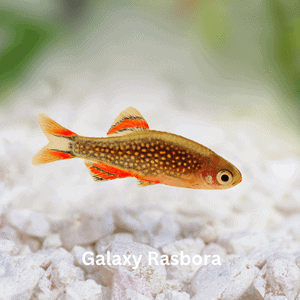
The Galaxy Rasbora (Danio margaritatus) is a small and graceful fish species that are a popular choice for many aquarists. These fish have a unique and attractive appearance, with their silver bodies covered in black speckles, making them a standout addition to any aquarium.
Size and Appearance
Galaxy Rasboras are small fish, reaching a maximum length of about 1.5 inches. They have a sleek, slender body shape that is adorned with an eye-catching pattern of silver and black spots. Their fins are also usually tinged with red, adding to their appeal.
Tank Requirements
Galaxy Rasboras are best kept in a well-planted aquarium of at least 20 gallons, although larger tanks are preferred. They are comfortable in a range of water conditions, but prefer a temperature of around 75-80°F and a pH of 6.0-7.5. They also need plenty of swimming space and hiding places, so be sure to include plenty of plants and other hiding spots in their tank.
Diet and Feeding
Galaxy Rasboras are omnivores, and will feed on a variety of foods including flakes, pellets, frozen and live foods. Be sure to offer a varied diet, including a mix of different protein and vegetable-based foods, to keep them healthy and thriving. These fish are not particularly picky eaters, but it is important to ensure that they are receiving a balanced diet to maintain their health.
Behavior and Compatibility
Galaxy Rasboras are peaceful and active fish that do well in a community aquarium. They are social creatures and do best in groups of at least six, although larger groups are preferred. They are also compatible with other peaceful fish species, and make great tank mates for a variety of other species including tetras, guppies, and other rasboras.
Breeding
Galaxy Rasboras are easy to breed in the aquarium, and will often breed spontaneously if conditions are favorable. They lay their eggs on plants or other flat surfaces, and the eggs will hatch after about 2-3 days. The fry will grow quickly and should be fed a diet of small live or frozen foods to ensure their healthy development.
Mosquito Rasbora (Boraras Brigittae)
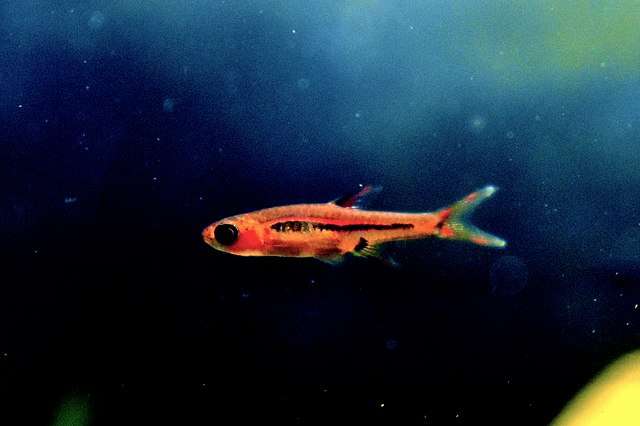
The Mosquito Rasbora is a small and brightly colored fish that is perfect for adding a pop of color to your aquarium. They are native to the Mekong Basin in Southeast Asia and typically grow to around 1.5 cm in length.
Appearance:
The Mosquito Rasbora has a slim, elongated body that is covered in a bright red color with a black stripe running vertically along the side of the body. The female Mosquito Rasbora is less vibrant than the male and has a more silver coloration.
Tank Requirements:
The Mosquito Rasbora is a peaceful and active fish that is best kept in a group of at least six to eight individuals. They require a tank that is at least 20 gallons in size and should have plenty of hiding spots and swimming space. They prefer a water temperature between 74 and 80°F with a pH range of 6.0 to 7.5.
Diet:
The Mosquito Rasbora is an omnivore and will accept a variety of food types, including small frozen and live foods such as brine shrimp, bloodworms, and daphnia. They should be fed two to three small meals per day.
Breeding:
The Mosquito Rasbora is a relatively easy species to breed in the aquarium. They prefer a well-planted tank with a dim lighting system. The female will lay her eggs in the plants, and the male will then fertilize them. The eggs will hatch in 24 to 36 hours, and the fry will be free swimming in about a week.
Male to Female Ratio:
For optimal breeding, it is recommended to have a male to female ratio of one to two.
Health Concerns:
The Mosquito Rasbora is a hardy species that is not prone to many health problems. However, they are susceptible to bacterial infections and parasites if the water conditions in their tank are not maintained properly. Regular water changes and proper filtration will help to keep them healthy.
In conclusion, the Mosquito Rasbora is a small, brightly colored fish that is perfect for adding a pop of color to your peaceful aquarium. They are easy to care for, hardy, and a great species for both novice and experienced aquarists alike.
Lambchop Rasbora
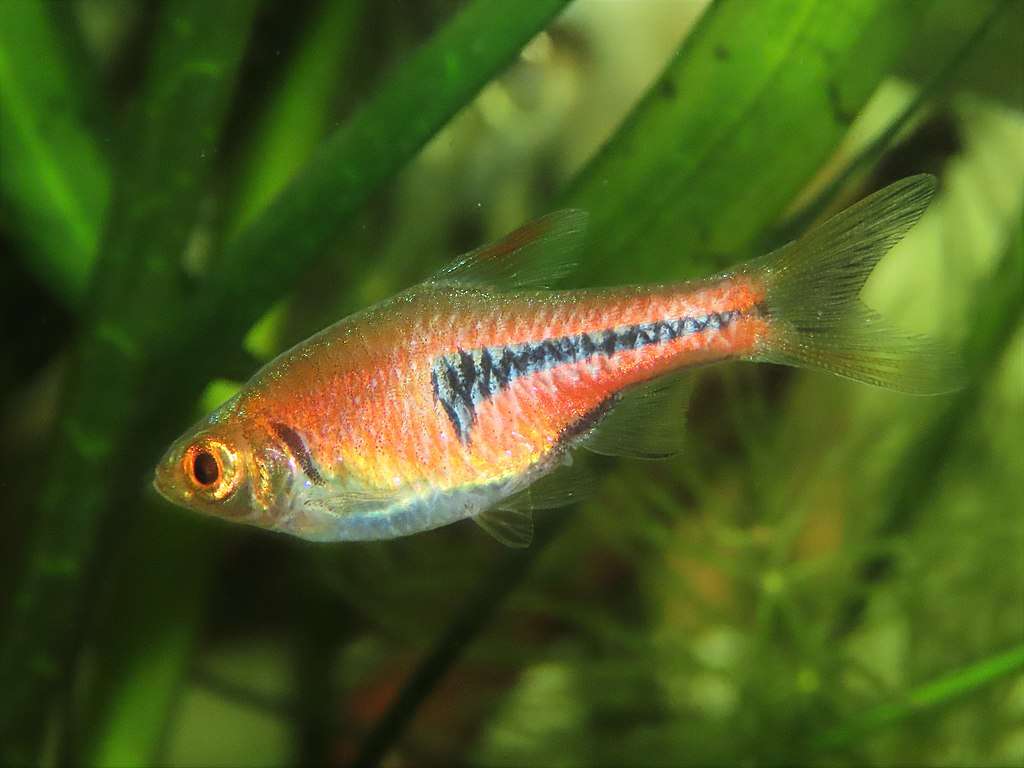
The Lambchop Rasbora (Trigonostigma espei) is a peaceful and small species that is a great addition to any peaceful community aquarium. They are easily recognizable by their unique and striking appearance, which features a striking red patch on their lower body and a black band that runs from the top of their head to the end of their tail. They are also known for their energetic and active personalities, which make them a fun and interesting addition to any tank.
Appearance:
The Lambchop Rasbora is a small fish, typically reaching only about 2 inches in length when fully grown. They have an elongated body shape, with a narrow and streamlined profile that allows them to swim quickly and easily through the water. They have a red patch on the bottom half of their body and a black band that runs from the top of their head to the end of their tail, giving them a unique and striking appearance.
Habitat:
Lambchop Rasboras are native to streams and rivers in Southeast Asia, and they thrive in well-oxygenated, clear water environments with a moderate flow. In the wild, they typically inhabit areas with dense vegetation, where they can find plenty of hiding places and food. In the aquarium, they need plenty of swimming space, as well as plenty of hiding places and visual barriers, such as plants and rocks.
Water Conditions:
Lambchop Rasboras are relatively easy to care for, but they do require stable and appropriate water conditions to thrive. The ideal water temperature for Lambchop Rasboras is between 75 and 82°F, with a pH range of 6.0 to 7.5. They also require a moderate level of water hardness, with a range of 4 to 12 dKH. To maintain these water conditions, it is important to regularly test your aquarium water, and to perform regular water changes as needed.
Diet:
Lambchop Rasboras are omnivorous, and they will eat a variety of foods, including both live and frozen foods, as well as pellets and flake food. They especially enjoy eating small insects and crustaceans, such as brine shrimp and daphnia, as well as small pieces of meat, such as frozen bloodworms and krill. To keep your Lambchop Rasboras healthy and happy, it is important to feed them a balanced diet, providing them with a variety of food sources and feeding them small, frequent meals throughout the day.
Breeding:
Breeding Lambchop Rasboras is relatively easy, and they are a good choice for beginner aquarium hobbyists who are interested in breeding fish. To breed Lambchop Rasboras, you will need to provide them with a breeding tank that is at least 20 gallons in size, and that has a water temperature between 75 and 82°F, a pH of 6.0 to 7.5, and a moderate level of water hardness. You should also provide them with plenty of hiding places and visual barriers, such as plants and rocks.
Lambchop Rasboras are egg-laying fish, and they will lay their eggs on flat surfaces, such as leaves or the sides of rocks. The eggs will hatch in about 3 to 5 days, and the fry will be free-swimming in about 7 to 10 days. To care for the fry, you will need to feed them small amounts of live or frozen foods, and to keep the water conditions in the breeding tank stable and appropriate.
Siamese Rasbora (Boraras brigittae)
The Siamese Rasbora is a small, delicate, and colorful species of fish that is well-suited for peaceful community tanks. They are known for their unique appearance, which includes a black stripe that runs vertically down their body and bright, vibrant fins. They are also known for their shy and timid behavior, making them a great addition to a peaceful and calm tank environment.
Appearance and Physical Characteristics:
The Siamese Rasbora is a small fish, usually only growing to a maximum of 2 cm in length. They have a distinct black stripe that runs vertically down their body, which contrasts beautifully with their bright, vibrant fins. Their fins are usually red, orange, or yellow, making them a colorful addition to any aquarium.
Habitat and Tank Requirements:
Siamese Rasboras are native to the freshwater streams and rivers of Southeast Asia, so it’s essential to recreate their natural habitat in the aquarium. They prefer water that is soft and slightly acidic, with a pH level of between 6 and 7.5. The temperature should be between 22°C and 25°C, and the water should be well-filtered and well-oxygenated.
Siamese Rasboras are best kept in a peaceful community tank with other small, peaceful fish. They are not aggressive, so they should not be kept with larger, more boisterous fish that may scare or harm them. A minimum tank size of 30 gallons is recommended for keeping a group of Siamese Rasboras.
Diet and Feeding:
Siamese Rasboras are omnivores, and they will eat a variety of food, including live, frozen, and dried foods. They will readily accept flake food, brine shrimp, and daphnia, as well as other live and frozen foods. They should be fed small amounts of food several times a day.
Breeding:
Siamese Rasboras are relatively easy to breed, but they are not considered a prolific species. To breed them, you will need to provide them with optimal water conditions, including a pH level of between 6 and 7.5 and a temperature of 22°C to 25°C. They are egg-scatterers, so the eggs will be scattered throughout the tank. Once the eggs have hatched, the fry will need to be fed small amounts of food several times a day to ensure their survival.
Conclusion:
The Siamese Rasbora is a small, delicate, and colorful species of fish that is well-suited for peaceful community tanks. They are not aggressive and prefer water that is soft, slightly acidic, and well-oxygenated. They are easy to breed and will eat a variety of foods, including live, frozen, and dried foods. With their unique appearance and peaceful behavior, they make a great addition to any aquarium.
Clown Rasbora (Rasbora Hagenahli)
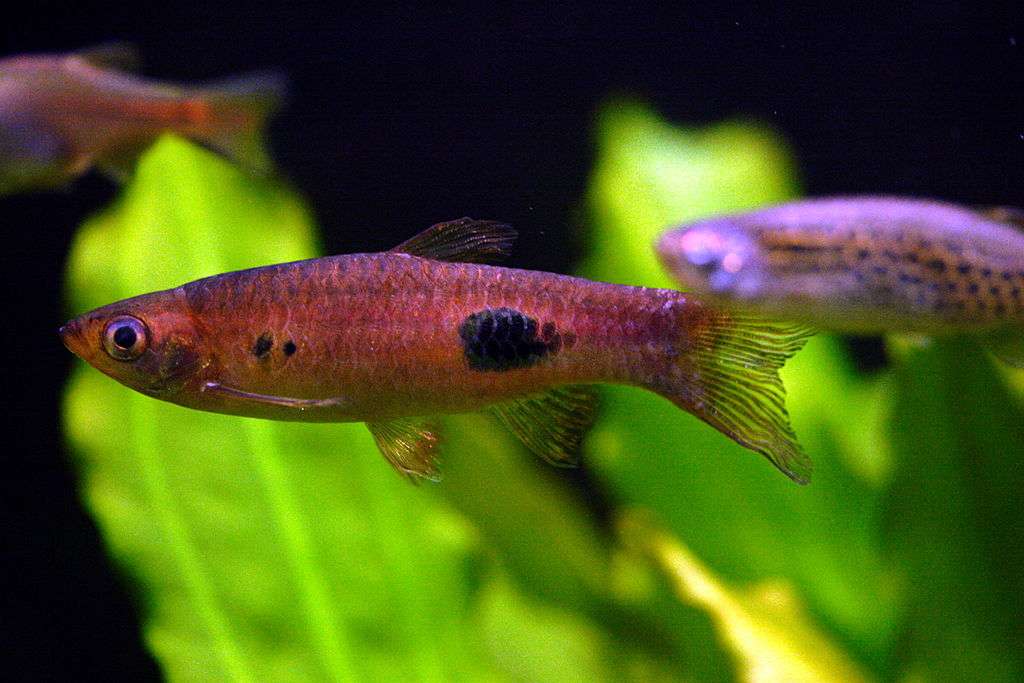
The Clown Rasbora is a small and vibrant fish that is loved for its unique appearance. This species of fish is native to Southeast Asia and is found in slow-moving rivers and streams. Clown Rasboras are hardy and easy to care for, making them a popular choice for aquarium owners.
Appearance:
The Clown Rasbora is a small fish that grows up to 2 inches in length. They are a deep red color with black stripes running along their body. This creates a striking contrast and makes them stand out in any aquarium.
Tank Size and Requirements:
Clown Rasboras are small fish and do not require a large aquarium. A 20-gallon tank is enough to keep a group of 6 to 8 fish. They prefer a well-planted tank with plenty of hiding places and a soft substrate.
Water Temperature and pH Balance:
Clown Rasboras prefer a water temperature between 72°F to 80°F and a pH balance between 6.0 to 7.5. These fish are hardy and can adapt to a range of water conditions, but it’s important to keep the pH levels stable for their overall health and well-being.
Feeding:
Clown Rasboras are omnivores and will eat a variety of food. They will readily accept flakes, pellets, and frozen foods. It’s important to feed them a balanced diet to ensure they receive all the necessary nutrients. They should be fed twice a day with small portions.
Breeding:
Breeding Clown Rasboras is relatively easy and they are known to breed in a community aquarium. They are egg-layers and will lay their eggs in the plants. The eggs will hatch after 2 to 3 days and the fry will be free-swimming after 5 days.
Male to Female Ratio:
For breeding purposes, it’s best to have a 1:2 ratio of males to females. This will increase the chances of breeding and ensure that the female fish do not become stressed.
Scissortail Rasbora (Rasbora trilineata)

The Scissortail Rasbora (Rasbora trilineata) is a beautiful and unique species of fish that is widely appreciated by hobbyists and aquarium enthusiasts alike. This species is known for its vibrant, iridescent coloration, active and playful behavior, and ease of care. If you are looking for a peaceful, colorful, and low-maintenance addition to your aquarium, the Scissortail Rasbora may be just what you need.
Appearance
The Scissortail Rasbora is a small fish that can reach a maximum length of approximately 2.5 centimeters (1 inch). It is characterized by its slender, streamlined body shape and its long, forked tail that resembles the shape of a scissor. This species is known for its iridescent coloration that ranges from silver to blue to green, depending on the angle and lighting in the aquarium.
Water Requirements
The Scissortail Rasbora is a hardy species that is well-adapted to a wide range of water conditions. It is generally recommended to keep this fish in an aquarium with a water temperature of 22 to 28 degrees Celsius (72 to 82 degrees Fahrenheit) and a pH range of 6.0 to 7.5. This species is relatively tolerant of slight variations in water chemistry, but it is important to maintain stable water conditions to prevent stress and illness.
Habitat
The Scissortail Rasbora is a schooling fish that is best kept in groups of 6 or more individuals. It is important to provide plenty of swimming space for this species, as well as plenty of hiding places and areas of shade. Live plants, such as Java Fern or Anubias, are ideal for providing hiding places and improving water quality.
Feeding
The Scissortail Rasbora is an omnivorous species that will readily accept a variety of different food types. This fish can be fed a diet of high-quality flake food, as well as live and frozen foods, such as brine shrimp, daphnia, and bloodworms. It is important to provide a varied diet to ensure that this species receives all of the essential nutrients it needs to thrive.
Breeding
The Scissortail Rasbora is a relatively easy species to breed, making it an ideal choice for aquarium hobbyists who are just starting to explore breeding fish. This species is best bred in a separate breeding tank with a water temperature of 25 to 28 degrees Celsius (77 to 82 degrees Fahrenheit) and a pH range of 6.5 to 7.0. The breeding tank should be well-planted, with plenty of hiding places and areas of shade.
Male to Female Ratio
It is recommended to keep a ratio of 1 male to 2 or 3 females in order to promote breeding. The males will court the females and encourage them to lay their eggs on the leaves of the plants in the breeding tank. The eggs will hatch in approximately 2 to 3 days, and the fry will become free-swimming in another 5 to 7 days.
Checker Rasbora (Rasbora maculata)
The Checker Rasbora, also known as the Spotted Rasbora or Spotted Danio, is a charming and peaceful fish that adds a pop of color to any aquarium. With its unique, checkerboard-like pattern, the Checker Rasbora is a sure standout in any community tank.
Appearance: The Checker Rasbora has a slender and streamlined body, with iridescent scales that glimmer in the light. Its most distinctive feature is its black and white, checkerboard pattern that covers its entire body. The fins of the Checker Rasbora are typically transparent, with a hint of red in the males.
Tank requirements: The Checker Rasbora is a hardy fish that is easy to care for and suitable for beginners. It is best kept in a well-planted tank that is at least 20 gallons in size, with a good filtration system to maintain water quality. The water temperature should be between 72-82°F, with a pH level between 6.0-7.0.
Diet: The Checker Rasbora is an omnivorous fish that will eat both plant-based and meaty foods. It is best to provide a variety of foods, including flakes, pellets, and live or frozen foods such as brine shrimp, bloodworms, and daphnia. It is important to not overfeed the Checker Rasbora, as they are prone to overeating and may develop health problems as a result.
Breeding: Breeding the Checker Rasbora is relatively easy and can be done in a community tank. The female Checker Rasbora will lay her eggs on a flat surface, such as a leaf or a piece of wood, and the male will then fertilize them. The eggs will hatch within 24-36 hours and the fry will be free swimming within a few days. It is important to provide good water quality and plenty of food for the fry to ensure their survival and growth.
Redline Rasbora (Rasbora pauciperforata)

The Redline Rasbora is a unique and striking species of fish that is well suited for the home aquarium. Native to the freshwater streams and rivers of Southeast Asia, these fish are known for their vibrant red stripes and sleek, slender bodies.
Appearance: The Redline Rasbora has a long, slender body that is covered in shimmering iridescent scales. They are usually a silver or metallic grey color with a series of bright red stripes that run horizontally along the body. The fins are usually a light translucent color with black edges. The fish grow to be around 2 inches in length and are one of the smaller species of rasbora.
Care: The Redline Rasbora is a hardy and adaptable species that can thrive in a variety of aquarium conditions. They prefer a temperature range of 72 to 82°F, a pH level between 6.0 and 7.5, and a moderate to low water flow. The tank should have plenty of hiding spots and plenty of open swimming space. These fish are best kept in schools of 6 or more and do well in aquariums that are at least 20 gallons in size.
Diet: The Redline Rasbora is an omnivore that will eat both plant and animal matter. They will readily accept a variety of foods including flakes, pellets, and frozen or live foods. It is important to provide a balanced diet that includes a variety of food types to ensure good health and vitality.
Breeding: Breeding Redline Rasboras is not particularly difficult, but it can be challenging to raise the young. The best way to breed these fish is to provide them with an optimal environment, good water quality, and a varied diet. The female will lay her eggs in a hidden location and the male will fertilize them. The eggs will hatch after several days and the fry will start to swim around. It is important to provide plenty of food and hiding spots for the fry and to keep the water quality high.
The Redline Rasbora is a wonderful addition to any peaceful and colorful aquarium. With their vibrant colors and hardy nature, they are a great choice for both experienced and novice aquarium hobbyists. Whether you are looking for a lively school of fish to add interest to your tank or just want a colorful and peaceful species to keep, the Redline Rasbora is an excellent choice.
Dwarf Rasbora (Boraras Brigittae)
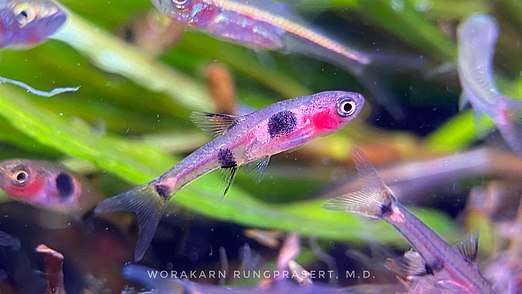
Dwarf Rasbora, also known as Boraras Brigittae, is a small species of freshwater fish that is commonly kept in aquariums. They are popular for their vibrant colors and peaceful nature, making them a great addition to any community tank. These fish are relatively easy to care for, making them a great option for novice aquarists.
Appearance: Dwarf Rasbora is a small fish, growing to a maximum size of just 1.5 cm. They are brightly colored, with a vibrant red body and a black line running along the lateral side of their body. Their fins are also brightly colored, with a translucent appearance.
Habitat: Dwarf Rasbora are native to Southeast Asia, and they are commonly found in slow-moving streams and rivers. In the wild, they typically inhabit shallow waters with plenty of vegetation and structures for cover.
Tank Requirements: When keeping Dwarf Rasbora in an aquarium, it is important to provide them with a spacious and well-maintained environment. A minimum tank size of 10 gallons is recommended, and it should be filled with a soft and acidic water that mimics their natural habitat.
Water Parameters: Dwarf Rasbora are best kept in a water temperature range of 72-82°F, and a pH level of 6.0-7.5 is ideal for their wellbeing. It is also important to maintain good water quality by performing regular water changes and monitoring the levels of nitrates, ammonia, and nitrites.
Diet: Dwarf Rasbora are omnivorous, and they feed on a variety of foods in the wild, including small insects, algae, and other small crustaceans. In the aquarium, they can be fed a diet of high-quality flakes, frozen or live foods, and occasionally, small amounts of vegetation.
Breeding: Dwarf Rasbora are relatively easy to breed in the aquarium, and they are often bred for their bright coloration and peaceful nature. The breeding process typically involves a group of 6-10 individuals, and it is important to provide a suitable spawning area with plenty of vegetation and structures for cover.
Health: Dwarf Rasbora are generally healthy fish, but they can be prone to some common health issues such as parasitic infections and bacterial diseases. To prevent these issues, it is important to maintain good water quality and to provide a varied and nutritious diet.
Overall, Dwarf Rasbora is a great choice for anyone looking to add some vibrant and peaceful fish to their aquarium. With their bright colors and easy-to-care-for nature, they are sure to bring life and energy to any tank.
Rummy Nose Rasbora (Rasbora rume)

The Rummy Nose Rasbora, also known as the Red Rasbora, is a small and vibrant species of fish that is native to Southeast Asia. It gets its name from the bright red coloration on its nose, which is set against its otherwise pale silver body. These fish are peaceful and sociable, making them ideal for community tanks. They also make for an excellent addition to a peaceful and colorful tank, as their lively personality and bright coloration will bring life to any aquarium.
Appearance: The Rummy Nose Rasbora is a small fish, typically growing to only 2 cm in length. It has a cylindrical body shape with a long and streamlined appearance, which is common among rasboras. Its body is silver-grey with a metallic shine, which is accented by the bright red coloration on its nose. This red nose is one of the most distinctive features of the Rummy Nose Rasbora and sets it apart from other species of rasboras.
Water Requirements: Rummy Nose Rasboras are native to Southeast Asia, where they can be found in slow-moving streams and rivers. As such, they prefer neutral to slightly acidic water with a pH between 6.0 and 7.5. They also prefer water temperatures between 72°F and 80°F. It is important to maintain a stable water temperature and pH to ensure the health of the fish.
Tank Requirements: Rummy Nose Rasboras are small fish and do not require a large aquarium. A tank of at least 20 gallons is recommended, with a capacity of 30 gallons or more being even better. They prefer a well-planted tank with plenty of hiding places and swimming space. They also do well with a good filtration system, as well as a water change regimen to keep the water quality high.
Feeding: Rummy Nose Rasboras are omnivores and will eat a variety of food, including small live, frozen, and dried foods. They will also eat pellets and flake food, but it is important to vary their diet to ensure they get all the necessary nutrients. They should be fed small amounts of food two to three times a day.
Breeding: Rummy Nose Rasboras are known to be difficult to breed in captivity, so this is not recommended for the average hobbyist. However, for those with experience and the right setup, Rummy Nose Rasboras will lay their eggs on fine-leaved plants or on the aquarium walls. The eggs will hatch in 2 to 3 days, and the fry should be fed small amounts of newly hatched brine shrimp or micro worms.
Brilliant Rasbora (Rasbora einthovenii)
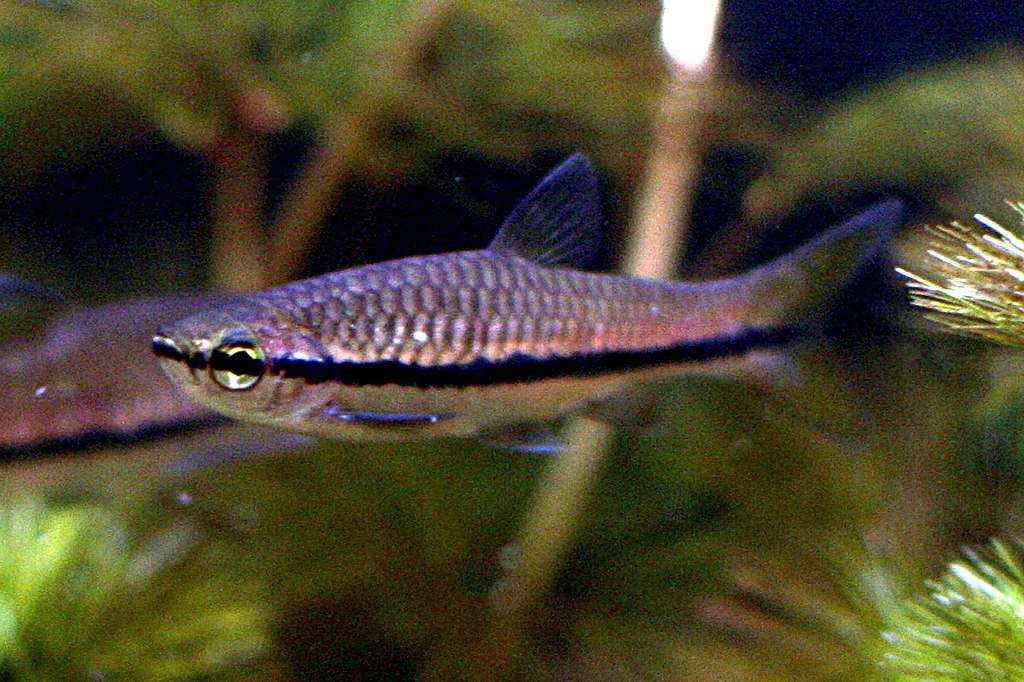
The Brilliant Rasbora, also known as Einthoven’s Rasbora, is a species of freshwater fish that is highly sought after by aquarium enthusiasts for its vibrant colors and active behavior. This species is native to Southeast Asia, and it is a small fish that grows to a maximum length of approximately 2 inches.
Physical Characteristics
The Brilliant Rasbora is a small and slender fish that has a unique and vibrant appearance. This species has a silver-colored body with a metallic shine that is accentuated by its striking black lateral line. The dorsal fin of the Brilliant Rasbora is tall and triangular in shape, and it has a bright red color that contrasts well against its silvery body. The caudal fin of this species is also tall and has a red color, while the anal and pelvic fins are transparent.
Behavior
The Brilliant Rasbora is an active and lively fish that loves to swim and play in the aquarium. This species is a peaceful fish that is well-suited to life in community aquariums, and it can be kept with other peaceful species of fish without any problems. The Brilliant Rasbora is a schooling fish that prefers to be kept in groups of six or more individuals, and it will swim in tight schools as it moves around the aquarium.
The Brilliant Rasbora is a relatively hardy species that is easy to care for in the home aquarium. This species is adaptable to a wide range of water conditions and will tolerate temperatures between 72-79°F, a pH between 6.0-7.5, and a hardness between 5-12 dKH. This species does best in well-planted aquariums that provide plenty of hiding places and open swimming spaces. The Brilliant Rasbora is not demanding when it comes to food and will accept a variety of dry, frozen, and live food items.
Breeding
The Brilliant Rasbora is an egg-laying species that will lay its eggs in a variety of places throughout the aquarium. This species is not difficult to breed in the home aquarium, but it is important to provide a suitable environment and good water conditions to ensure that the eggs and fry survive. The Brilliant Rasbora is a prolific breeder, and it is not uncommon to see large numbers of eggs and fry in the aquarium when breeding conditions are optimal.
Yellow Tail Rasbora (Rasbora caudimaculata)
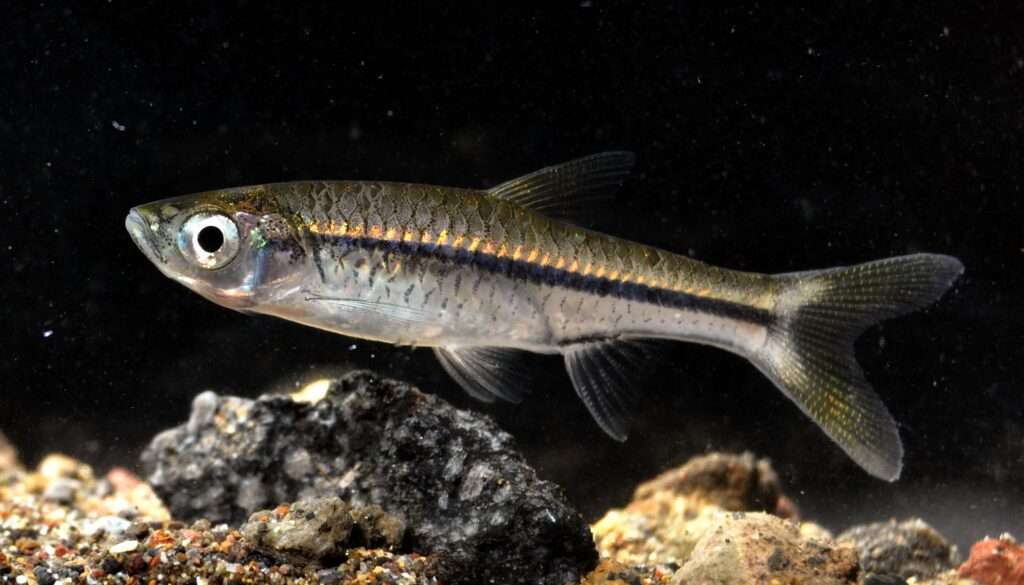
The Yellow Tail Rasbora is a stunning species that is known for its vibrant coloration and peaceful nature. This species is often sought after by aquarium hobbyists for its unique yellow tail fin and its ability to add a pop of color to any aquarium setup.
Appearance: This species is small in size and can grow up to 2.5 cm in length. The body of the Yellow Tail Rasbora is a shimmering silver color with a striking yellow tail fin. The male of this species has a slightly more vibrant coloration, which becomes more pronounced during breeding.
Behavior: Yellow Tail Rasboras are a peaceful species that are ideal for community tanks. They get along well with other fish species, making them a great addition to a community of small fish. This species is active and swims in mid to top water levels, and they are known to form small schools.
Aquarium Requirements: The Yellow Tail Rasbora is an easy species to care for, and they are well suited to beginner aquarium hobbyists. They do best in aquariums that are at least 10 gallons in size and they prefer water temperatures between 72-82°F. This species requires a pH level between 6.0-7.0 and a water hardness between 5-15 dGH.
Diet: The Yellow Tail Rasbora is an omnivore, and they will readily consume a variety of foods. They can be fed live, frozen or dried food, including brine shrimp, bloodworms, and dried pellets. To maintain optimal health, it is recommended to feed this species a balanced diet of both vegetable and meat-based foods.
Breeding: The Yellow Tail Rasbora is a livebearer species, meaning they give birth to live young. To encourage breeding, it is recommended to keep a group of at least six individuals in an aquarium with hiding places, such as plants or caves. The female will give birth to between 20-40 young, and the fry are capable of swimming and eating immediately after birth.
Conclusion
Rasboras are a popular and versatile choice for aquarium enthusiasts looking to add color and tranquility to their tanks. With so many species to choose from, it can be difficult to decide which ones are right for you. However, by considering factors such as water parameters, size, and temperaments, you can find the perfect rasbora species to meet your needs. From the vibrant Harlequin Rasbora to the peaceful Blackline Rasbora, each species offers its own unique charm and personality. With proper care, a group of rasboras can thrive and bring joy to your aquarium for years to come.
FAQs
What are rasboras and why are they popular in aquariums?
A: Rasboras are small, brightly colored fish that are popular in aquariums for their peaceful nature and vibrant colors. They are part of the Cyprinidae family and are native to Southeast Asia.
What size aquarium do I need for rasboras?
A: It is recommended to keep at least 5-6 rasboras in a 10-20 gallon tank. A larger tank size is better if you want to keep a larger group of rasboras.
What is the optimal water temperature for rasboras?
A: Rasboras prefer a water temperature of 72-82°F. They are a tropical fish species and need a warm environment to thrive.
What is the best pH range for rasboras?
A: Rasboras prefer a pH range of 6.0-7.5. A slightly acidic to neutral water environment is best for their health and well-being.
What type of food should I feed my rasboras?
A: Rasboras are omnivores and eat a variety of foods including flake food, frozen food, live food, and even some plants.
How often should I feed my rasboras?
A: Rasboras should be fed two to three times a day with small amounts of food at each feeding. It is important not to overfeed them as this can lead to water quality issues and poor health.
What are some common health issues that rasboras may face?
A: Some common health issues that rasboras may face include parasites, bacterial infections, and poor water quality. Proper water maintenance and a balanced diet can help prevent these issues.
Can I keep rasboras with other fish species in my aquarium?
A: Yes, rasboras are known for their peaceful nature and can be kept with other peaceful fish species. It is important to research and make sure that the other fish species are compatible with rasboras in terms of water temperature, pH levels, and size.
What are some tips for breeding rasboras in an aquarium?
A: Some tips for breeding rasboras in an aquarium include maintaining optimal water conditions, providing adequate hiding places, and feeding a balanced diet. It is also important to separate breeding pairs from the main tank to prevent any aggression towards the offspring.
Can I keep multiple types of rasboras in the same aquarium?
A: Yes, multiple types of rasboras can be kept in the same aquarium as long as they are compatible in terms of water temperature, pH levels, and size. It is important to research and make sure that the different species of rasboras will get along before adding them to the same tank.
You may also be interested in other articles in this blog, please check out The Ultimate Guide to 10 Best Low-Maintenance Fish for a Beginner Aquarium in 2023
References in the Aquarium hobby
- American Association of Aquatic Animal Veterinarians (AAAV) – https://www.aaav.org/ This is a professional organization for veterinarians specializing in the care of aquatic animals, including freshwater fish. They provide resources and information on fish health, disease, and husbandry.
- American Livebearer Association (ALA) – http://www.livebearers.org/ The ALA is a national organization dedicated to promoting the keeping and breeding of livebearers, which are a group of freshwater fish that give birth to live young. They provide information and resources on livebearer species, care, and breeding.
- Aquatic Gardeners Association (AGA) – https://www.aquatic-gardeners.org/ The AGA is an international organization dedicated to promoting the art and science of aquarium plants and freshwater fish keeping. They provide information, resources, and events for aquarium hobbyists and professionals.
- International Association of Fish Veterinarians (IAFV) – http://www.iafv.org/ The IAFV is a professional organization for veterinarians who specialize in the care of fish and aquatic animals. They provide resources, information, and continuing education opportunities for members.
- North American Native Fishes Association (NANFA) – https://www.nanfa.org/ The NANFA is a non-profit organization dedicated to promoting awareness and conservation of North American native freshwater fish species. They provide information, resources, and events for hobbyists and professionals interested in these species.
- The Aquarium Club – https://theaquariumclub.com/ The Aquarium Club is a community for freshwater aquarium hobbyists. They provide information, resources, and a forum for discussion on freshwater fish keeping and aquarium maintenance.
- The Ornamental Aquatic Trade Association (OATA) – https://www.ornamentalfish.org/ The OATA is a trade association for the ornamental aquatic industry in the UK. They provide resources, information, and support for businesses and hobbyists in the freshwater aquarium industry.
- The Fish Health Section of the World Aquaculture Society (WAS) – https://was.org/fish-health/ The Fish Health Section of the WAS is dedicated to promoting best practices in fish health management for aquaculture and freshwater fish keeping. They provide resources, information, and events for professionals and hobbyists in the industry.
- Tropical Fish Keeping – https://www.tropicalfishkeeping.com/ Tropical Fish Keeping is a website and community for freshwater aquarium hobbyists. They provide information, resources, and a forum for discussion on all aspects of freshwater fish keeping.
- The Aquatic Experience – https://www.aquaticexperience.org/ The Aquatic Experience is an event for freshwater aquarium hobbyists and professionals. They provide a platform for education, networking, and showcasing the latest products and trends in the industry.
I am a passionate aquarist with over 30 years of hands-on experience in fishkeeping. My journey began at a young age, collecting fish from the wild and learning through experimentation. Specializing in tropical fish, I bring a deep understanding of the hobby to FishKeepingMadeSimple. The site provides honest, detailed reviews of essential products and accessories to help fellow enthusiasts create the best environments for their fish.

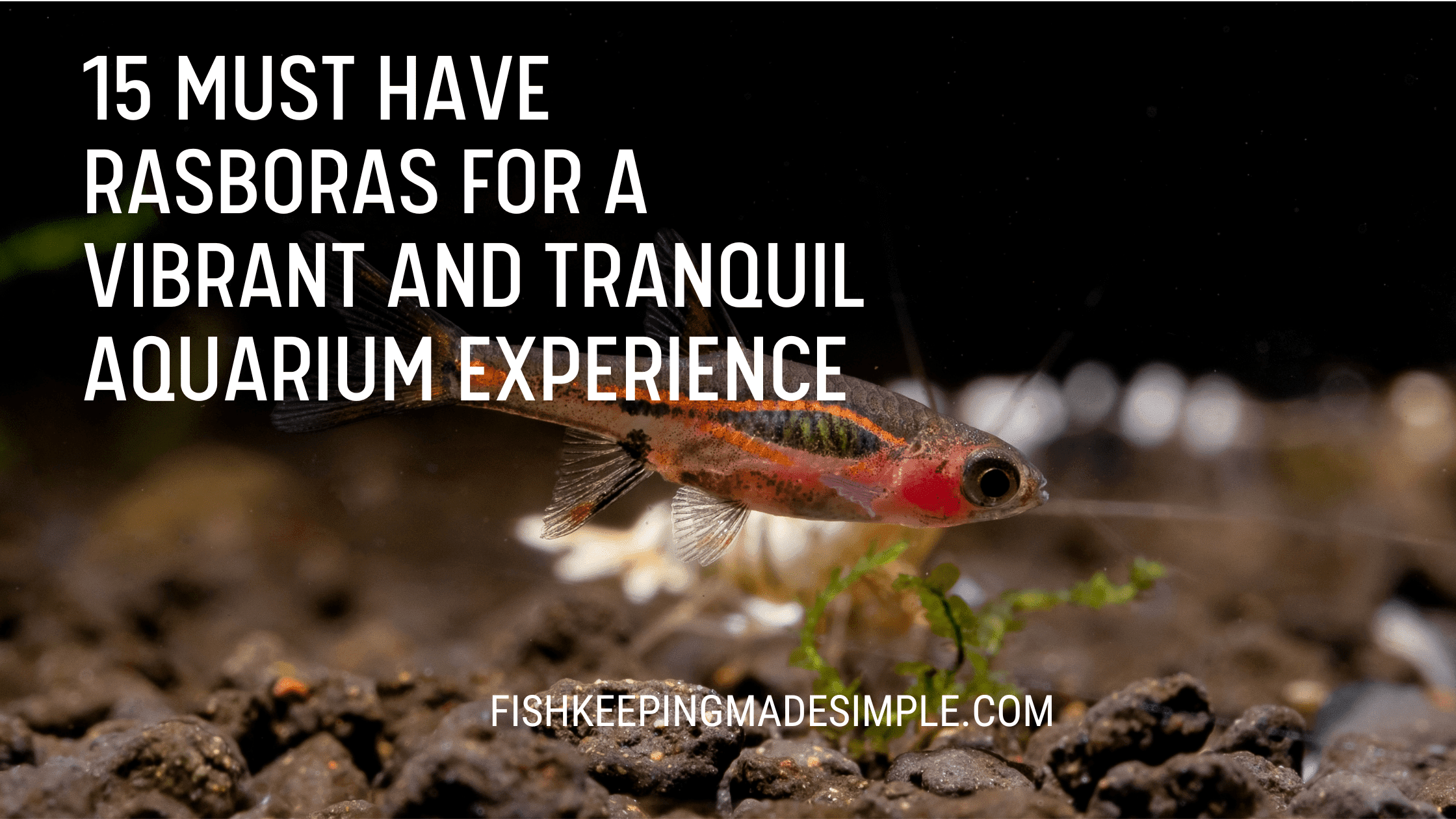








[…] Harlequin Rasboras: Harlequin Rasboras are small, peaceful fish that get along well with Vampire Plecos. They are known for their striking colors and active behavior. […]
[…] Harlequin Rasboras need specific conditions like slightly acidic blackwater environments and temperatures between 72°F to 81°F. […]
[…] Dwarf Rasboras […]